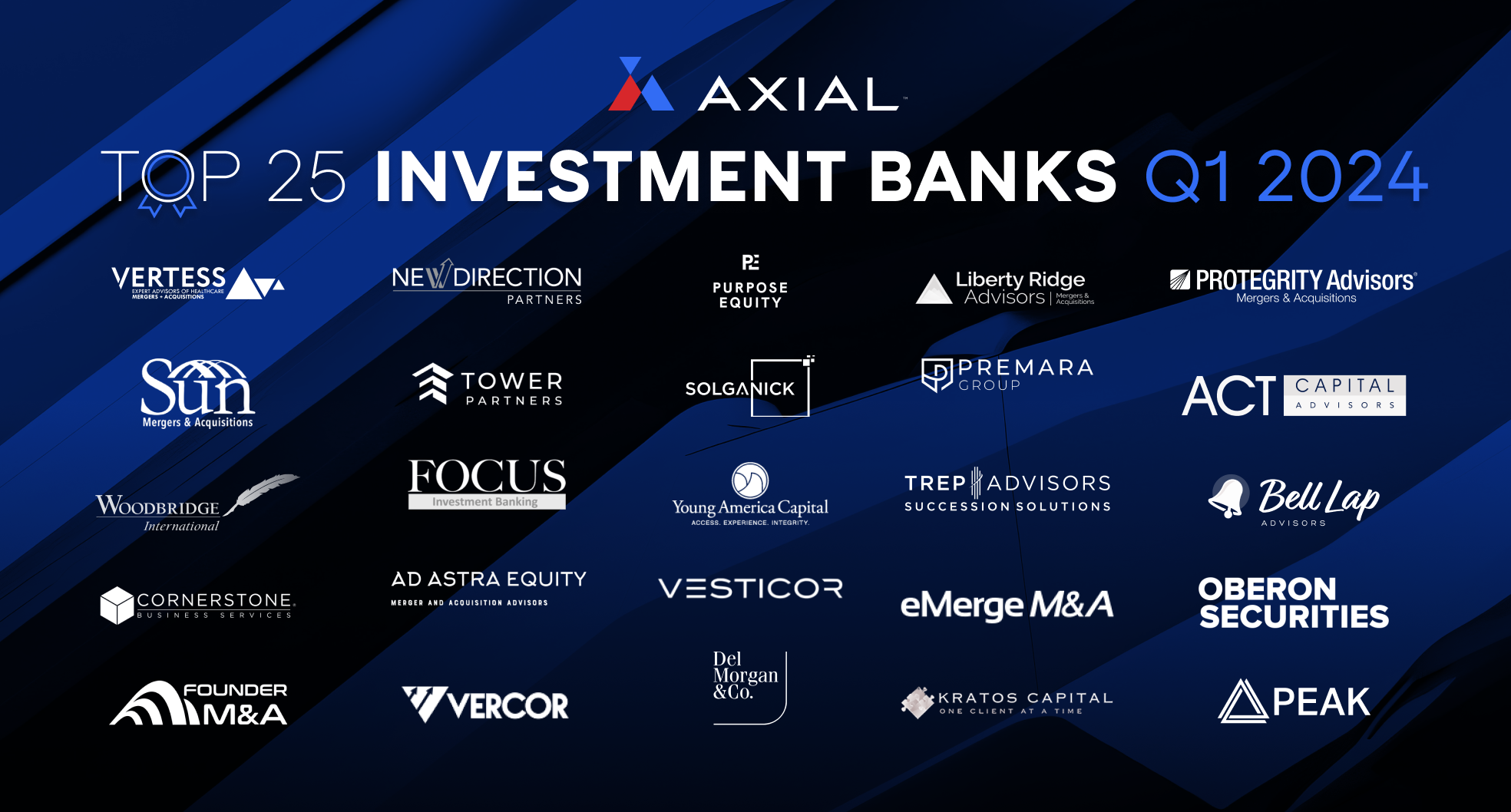
Top 25 Lower Middle Market Investment Banks | Q1 2024
Axial is excited to release our Q1 2024 Lower Middle Market Investment Banking League Tables. To assemble this list, we…
Tags
Capstone Partners and Headwaters MB, two respected middle market investment banks, made waves on Monday when they announced their transaction, combining to become Capstone Headwaters. We sat down with John Ferrara, CEO of the combined entity (and Capstone founder) to discuss the transaction and some broader industry trends.
Ferrara: The middle market has evolved and become much more sophisticated. We are in world where scale, depth of industry expertise and global reach really matter. We founded both companies around the same time back in 2001 and 2002, and have kept a close relationship ever since. Our senior bankers knew each other and would get together periodically to discuss strategies and trends. We started to discuss the possibility of a combination 5 years ago, and in 2017 decided that if we were going do it, this was the year.
The typical trend in middle market M&A is for banks to try to move upstream, but in our case, we did not want to change our focus. We are still focused on transactions between $25M and $250M in enterprise value. The merger has allowed us to expand both our industry coverage and geographic coverage. Beyond M&A and capital raising, both firms brought new capabilities to the table. Headwaters had strong financial sponsor coverage and a debt placement group, and Capstone had a fast-growing corporate restructuring practice and a dedicated research team.
Ferrara: We have 150 professionals, with 60 senior bankers, who work in 16 industry verticals and across 20 offices. 18 of the offices are in the USA, and we have offices in London and San Paolo.
Ferrara: Ours is a human capital business. We knew that if we didn’t get that right, the merger would fail. We agreed on terms in March of 2017 but did not close the transaction until the end of the year, specifically because we wanted to take our time. We started and ended the process with people and culture. By the time we closed the transaction, all the senior bankers knew each other and were off and running on the integration of our brands and systems.
Ferrara: We are expanding geographically in Atlanta and DC, and will likely grow in Texas and the Pacific Northwest. We might do some small tuck-in acquisitions. Our corporate restructuring practice is one of our rising stars. It’s a highly fragmented market segment that represents an attractive growth opportunity for us. Ultimately, I would like to see the growth of that practice mirror its M&A practice predecessor.
Our primary focus right now is the successful integration of this deal and rolling out our new capabilities to the broader market. We are now one of the largest independent middle market investment banking firms in the country. Someday, when we are finished with our domestic growth strategy, we will likely look internally to Central European expansion. A record high volume of middle market transactions in 2017 involved foreign acquirers, and it only makes sense for us to expand our global footprint.
Ferrara: That’s the million-dollar, crystal ball question. I think there are three major factors to consider: first, the massive overhang of private equity capital; second, the availability and pricing of acquisition financing; and third, the aging population of middle market business owners.
The market took a bit of a breather in 2017 but those three factors are going to keep the market very healthy, barring a major, unforeseen geo-political event. Many of the transactions that we saw slated for a Q4 close were pushed back to Q1 in order to capture any potential benefits from changes in the tax code. I think Q1 numbers in 2018 will be ahead of last year and we are anticipating that it could be significant.
In terms of valuations, we’ve been operating in a dislocated market. We have an over-abundance of capital looking for acquisitions and a natural, finite number of sellers at any given point in time. It has created a fiercely competitive bidding environment. We have seen deals in the last 12 months where 6.5-7.5x EBITDA seemed like it would be in the middle of the bell curve, and the deals settled north of 10x. Similarly, in our tech practice, we have seen revenue multiples break through the 5x barrier.
It has gotten to the point where friends at several marquee private equity firms have told me that they might be sitting on the sidelines for a bit to let the valuation balloon come back down to earth. I have never heard that from a PE firm and take that as a pretty good indication that valuations are probably at their peaks.
Ferrara: Unfortunately, it has become more commonplace where we see the high bids, but the due diligence process is focused on knocking value down versus confirming the winning bid level. We are trying to front-load a lot of due diligence, and spending more time preparing to go to market. We want to avoid any problems popping up later in the process. We are actively including quality of earnings reports in our own due diligence before taking an asset to market and also moving the working capital peg negotiation to the forefront of the discussions so that there are not any 11th hour surprises.
Ferrara: Both consumer sentiment and CEO confidence is up. I recently read a survey done of middle market CEOs and 78% said that they were positive on forward looking growth and looking to invest in their businesses. That should bode well for companies looking to tap the M&A markets as well as for corporate buy-side interest.
Ferrara: It is possible. It’s always hard to see the other side of the mountain, especially for entrepreneurs who, in general, tend to have an aggressively optimistic view of the world. We think it is best to pursue the market when you don’t feel pressure to do a deal, and to think about a transaction when the dynamics are all in your favor.
Ferrara: The amount of PE capital raised is mind boggling. I ran some back-of-the-envelope numbers and as long as debt financing remains in place, my estimate is that the private equity field could skip raising another dollar for the next decade and still keep M&A markets at healthy levels. There has to be a point in time when the inflow slows down. Until that point, I remain bullish.
We have also seen pledge funds and independent sponsors become much more sophisticated. They are no longer a new thing. Many of them have become formidable buyers in the marketplace.
Ferrara: Yes, the market perception has changed. Independent sponsors are credible buyers, as are family offices. I’m a big believer in letting the market speak. I try not to unfairly judge bidders, and the burden is on them to be good buyers in competitive processes.
Ferrara: I love it. It’s something we’re working really hard to get our hands around. It’s one of the few areas where the market is still highly inefficient. Some time ago, we started researching about 2,300 family offices, trying to understand their strategies and decision-making processes. We’ve soft-circled 200 of them that we think will be early movers in middle market M&A.
Ferrara: The market will go one of two ways. Right now, it is hard for many family offices to compete in highly competitive processes because they haven’t built up a “deal machine” infrastructure like mature private equity firms. They will need to build that capability, or they may back out of direct investing.
Right now, family offices have a unique reputation advantage. They are generally seen by business owners as more pro-management, hands-off, and inclined to long-term thinking than a PE partner. To the extent family offices can source proprietary deals, by which I mean if they can get to know business owners ahead of a formal deal process, they have an edge. In a competitive bidding process, however, they are generally at a disadvantage in terms of speed of execution.
Ferrara: Absolutely. Together, we have a much broader product offering, more specifically targeted to the private equity community. We have a dedicated coverage team that now can offer more than just M&A deal flow. We have a debt placement desk, a sale-leaseback group, and a business consulting team that can deliver performance improvement, due diligence, quality of earnings and fairness opinion advisory services. Our new private equity partner program will be very attractive to the market. Beyond that, I think we are all just excited to put the deal behind us and focus on being great partners together and building a special kind of firm. This is a watershed deal for us, coming off 15 years of building both firms independently and we are expecting the combination to supercharge our growth strategy.
